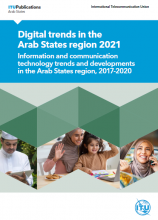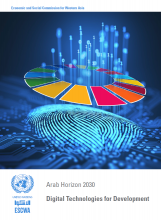ICT
Information and communications technology is considered a key enabler of economic and social development. Research estimates that during the last seven years (2010-2017), fixed broadband has had a significant impact on the world economy; an increase of 1 percent in fixed broadband penetration yields an increase in 0.08 percent in GDP. Mobile broadband has even proved to have a higher impact; an increase of 1 percent in mobile broadband penetration yields an increase in 0.15 percent in GDP.[1]
Worldwide, mobile-cellular subscriptions have been substituting fixed-telephone subscriptions. In the Arab region, mobile-cellular subscriptions have increased by around 38 percent between 2010 and 2019 and reached 100.6 per 100 inhabitants, whereas fixed-telephone subscriptions have increased by 7.7 percent during the same.[2] While fixed-broadband subscriptions are reaching saturation levels in Europe and the Americas, they continue to be low in the Arab region but increasing. Fixed-broadband subscriptions per 100 inhabitants are estimated at only 8.1 percent by the end of 2019 in the Arab region.[2] In terms of speed, a high share of subscribers at 31 percent in the Arab region, still had subscriptions at speeds below 2 Mbit/s in 2017, compared to a share of 89 percent in Asia and the Pacific and 87 percent in Europe at speeds equal or above 10 Mbit/s for the same year.
Mobile access is more flexible and more accessible than fixed-broadband. With the strong growth of the mobile broadband take-up worldwide, the Arab States were from the Regions with the strongest growth; with active mobile-broadband subscriptions estimated to grow as much as 50 percent at the end of 2019 compared to 2016. Furthermore, the Arab States registered a higher share for mobile traffic than for fixed. In some Arab countries, mobile technologies (such as Long-Term Evolution (LTE)) are being used to deliver fixed-broadband services.[3]
The percentage of individuals (% of total population) using the internet in the Arab region is estimated at 51.6 percent in 2019 with wide variations between the different Arab countries. Gulf Cooperation Council (GCC) countries registered the highest rates: Bahrain (99.7 percent). Quatar 99.65, Kuwait ( 99.54 percent), United Arab Emirates ( 99.15 percent) and Saudi Arabia ( 95.72 percent).
Based on latest data available, Iraq has the highest gender gap regarding the individuals using the internet- 98.3 percent of male compared to only 51.2 percent of female. However, Oman has more female internet users (96.8 percent) then male internet users (90.6).[2][4]
In line with the increase in the rates of fixed and mobile-broadband subscriptions and the percentage of the population using the internet, international bandwidth usage increased strongly as well, to satisfy the growing data needs. From a regional perspective, growth was the strongest in the Arab region, with a compound annual growth rate (CAGR) of 56 percent between 2014 and 2017.
According to the affordability targets set by the Broadband Commission for 2025, entry-level for broadband services should be less than 2 percent of monthly GNI p.c. in developing countries; this threshold was previously set at 5 percent in 2015.
Worldwide, mobile-broadband prices are more affordable than fixed-broadband prices. The same case is also noticeable in the Arab region. Mobile-broadband accessed through handset-based offer prices are more affordable than computer-based mobile-broadband. Corresponding prices were below the threshold of 2 percent of GNI p.c. in most Arab countries, and almost at that affordability level in Morocco, Iraq, and Algeria. In the case of computer-based, the group of countries with prices between 2 percent to 5 percent of GNI p.c. comprises the same countries in addition to Lebanon and Jordan. The only Arab countries in which mobile-broadband services were above the 2 percent threshold and therefore remained unaffordable to some segments of the population were Yemen, Comoros, Djibouti and Mauritania. All these countries are LDCs and have the lowest incomes in the region. Sudan is an exception to this categorization; with a percent of 0.94 percent of GNI p.c. in the case of handset-based mobile-broadband and 6.79 percent of GNI p.c. in the case of computer-based mobile-broadband.
Fixed-broadband prices represent less than 2 percent of GNI p.c. in all high-income GCC countries, except for Oman, as well as in Egypt and Tunisia. Other Arab countries with relatively affordable fixed-broadband services include Algeria, Lebanon, Libya, and Morocco, with all of them having prices that correspond to a range from 2 to 5 percent of GNI p.c. On the other hand, Comoros and Mauritania have the least affordable prices and the lowest fixed-broadband penetration in the region, along with Sudan.[5]
This overview has been drafted by the ADP team based on most available data as of November 2020.
Sources:
[1] International Telecommunications Union. 2018. The economic contribution of broadband, digitization and ICT regulation. Geneva. Switzerland. [Accessed 19 November 2020].
[2] International Telecommunications Union. 2019. Measuring digital development Fact and figures. [ONLINE] Available at: https://www.itu.int/en/ITU-D/Statistics/Pages/facts/default.aspx [Accessed 19 November 2020].
[3] International Telecommunications Union. 2018. Measuring the Information Society Report. Volume 1. Geneva. Switzerland & Ibid. [Accessed 19 November 2020].
[4] International Telecommunications Union. Country ICT data. 2020. [ONLINE] Available at: https://www.itu.int/en/ITU-D/Statistics/Pages/stat/default.aspx [Accessed 19 November 2020].
[5] International Telecommunications Union. 2018. [ONLINE] Available at: https://www.itu.int/en/Pages/default.aspx [Accessed 19 November 2020].
Data Highlights
-
The percentage of individuals (% of total population) using the internet in the Arab region has more than doubled in 2018 at 54.7% in 2018 up from 24% in 2010.




